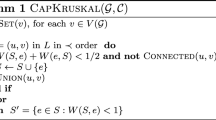Abstract
A wireless network’s design must include the optimization of the area of coverage of its wireless transmitters—mobile and base stations in cellular networks, wireless access points in WLANs, or nodes on a transmit schedule in a wireless ad-hoc network. Furthermore, with increasing densities of wireless network deployments, paucity of spectrum, and new developments like whitespace devices and cognitive networks, there is a need to study the computational efficiency of managing interference and optimizing coverage. This work presents new algorithms for computing and optimizing interference-limited coverage of wireless networks under protocol and Signal-to-Interference-and-Noise Ratio (SINR) models. For the protocol model we demonstrate lower bounds on computation of the coverage area for an \(n\) transmitter topology. We first show that any offline computation has a run-time of \(\varOmega (n\log {n})\), and any dynamic update takes \(\varOmega (\log {n})\) time to locate transmitters whose coverage is modified and \(\varOmega (k)\) time to update \(k\) affected coverage regions. We then demonstrate an extension of an offline algorithm to a dynamic algorithm that achieves the lower bound. For coverage in the SINR model, we demonstrate the difficulty of geometric direct computation, and report a flexible coverage area estimation method. We then propose a Random Hill Climbing method for optimizing the coverage area measure, and demonstrate the efficacy of this method by experimental comparison with the Nelder–Mead and exhaustive search optimization methods.

















Similar content being viewed by others
References
Ahmed, N., & Keshav, S. (2006a). SMARTA: A self-managing architecture for thin access points. In Proceedings of the CoNEXT Conference, ACM, p. 9.
Ahmed, N., & Keshav, S. (2006b). A successive refinement approach to wireless infrastructure network deployment. IEEE Wireless Communications and Networking Conference, 1, 511–519.
Alt, H., Knauer, C., & Wenk, C. (2001). Matching polygonal curves with respect to the fréchet distance. In Symposium on theoretical aspects of computer science (pp. 63–74). Springer.
Altman, E., Kumar, A., Singh, C., & Sundaresan, R. (2012). Spatial SINR games of base station placement and mobile association. IEEE/ACM Transactions on Networking (TON), 20(6), 1856–1869.
Aurenhammer, F. (1987). Power diagrams: Properties, algorithms and applications. SIAM Journal on Computing, 16(1), 78–96.
Aurenhammer, F., & Klein, R. (2000). Voronoi diagrams. Handbook of Computational Geometry, 5, 201–290.
Avin, C., Emek, Y., Kantor, E., Lotker, Z., Peleg, D., & Roditty, L. (2012). SINR diagrams: Convexity and its applications in wireless networks. Journal of the ACM, 59(4), 18:1–18:34.
Avriel, M. (2003). Nonlinear programming. New York: Dover Publications.
Bajaj, C. L., Pascucci, V., Shamir, A., Holt, R. J., & Netravali, A. N. (2003). Dynamic maintenance and visualization of molecular surfaces. Discrete Applied Mathematics, 127(1), 23–51.
Berberich, E., Eigenwillig, A., Hemmer, M., Hert, S., Mehlhorn, K., & Schömer, E. (2002). A computational basis for conic arcs and boolean operations on conic polygons. In Algorithms-ESA 2002 (pp. 174–186). Springer.
Brown, K. Q. (1979). Voronoi diagrams from convex hulls. Information Processing Letters, 9(5), 223–228.
Chan, T. M. (2006). A dynamic data structure for 3-D convex hulls and 2-D nearest neighbor queries. In Proceedings of the 17th symposium on discrete algorithms, ACM-SIAM (pp. 1196–1202).
Clarkson, K. L., & Shor, P. W. (1989). Applications of random sampling in computational geometry—II. Discrete Computational Geometry, 4, 387–421.
de Berg, M., van Kreveld, M., Overmars, M., & Schwarzkopf, O. (1997). Computational geometry. Berlin: Springer.
Demaine, E. D., Mitchell, J. S. B., O’Rourke, J. (2006). The open problems project, Problem 63. http://maven.smith.edu/orourke/TOPP/P63.html. Updated January 2006.
Flanagan, M. T. (2007). Java scientific library. http://www.ee.ucl.ac.uk/mflanaga/java. Last accessed May 2007.
Goussevskaia, O., Oswald, Y. A., & Wattenhofer, R. (2007). Complexity in geometric SINR. In Proceedings of the 8th international symposium on mobile ad-hoc networking and computing, ACM (pp. 100–109).
Gupta, P., & Kumar, P. R. (2000). The capacity of wireless networks. IEEE Transactions on Information Theory, 46(2), 388–404.
Hentilä, L., Kyösti, P., Käske, M., Narandzic, M., Alatossava, M. (2007). MATLAB implementation of the WINNER Phase II Channel Model ver1.1. https://www.ist-winner.org/phase_2_model.html. Last accessed May 2011.
Johnson, A., Jacobson, S. (2002). On the convergence of generalized hill climbing algorithms. Discrete Applied Mathematics, 119(12), 37–57. http://www.sciencedirect.com/science/article/pii/S0166218X01002645 (special Issue devoted to Foundation of Heuristics in Combinatorial Optimization).
Kapadia, P. R., Damani, O. P. (2006). Interference-constrained wireless coverage in a protocol model. In: Proceedings of the 9th international symposium on modeling, analysis, and simulation of wireless and mobile systems, ACM (pp. 207–211).
Lotker, Z., Parter, M., Peleg, D., & Pignolet, Y. A. (2011). Distributed power control in the SINR model. In Proceedings of the Infocom, IEEE (pp. 2525–2533).
Mitzenmacher, M., & Upfal, E. (2005). Probability and computing. Cambridge: Cambridge University Press.
Mudumbai, R., Wild, B., Madhow, U., Ramchandran, K. (2006) Distributed beamforming using 1 bit feedback: From concept to realization. In: Proceedings of the 44th Allerton conference on communication, control and computation (pp. 1020–1027).
Mulmuley, K. (1994). Computational geometry: An introduction through randomized algorithms (Vol. 54). Englewood Cliffs: Prentice-Hall.
Ohyama, T. (2010). Multiplicatively-weighted voronoi diagram. http://www.nirarebakun.com/voro/emwvoro.html. Last accessed May 2010.
Preparata, F. P., & Shamos, M. I. (1985). Computational geometry: An introduction. Berlin: Springer.
Singer, S., & Nelder, J. (2009). Nelder–Mead algorithm. Scholarpedia, 4(7), 2928.
So, A. M. C, Ye, Y. (2005). On solving coverage problems in a wireless sensor network using Voronoi diagrams. In Internet and Network Economics, Springer, pp. 584–593.
Tse, D., & Vishwanath, P. (2005). Fundamentals of wireless communication. Cambridge: Cambridge University Press.
Yates, R. D., & Huang, C. Y. (1995). Integrated power control and base station assignment. IEEE Transactions on Vehicular Technology, 44(3), 638–644.
Zander, J. (1992). Performance of optimum transmitter power control in cellular radio systems. IEEE Transactions on Vehicular Technology, 41(1), 57–62.
Author information
Authors and Affiliations
Corresponding author
Rights and permissions
About this article
Cite this article
Kapadia, P., Damani, O. & Kumar, A. Interference-constrained coverage algorithms in the protocol and SINR models. Wireless Netw 21, 1391–1409 (2015). https://doi.org/10.1007/s11276-014-0832-9
Published:
Issue Date:
DOI: https://doi.org/10.1007/s11276-014-0832-9




